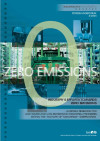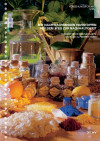Suchergebnisse
Sustainable Regional Planning In Austria

The project "Ökofit" - research for integrated technology
Forschungsforum
4/1996
Herausgeber: BMVIT
Englisch, 6 Seiten
Berichte aus Energie- und Umweltforschung 4/2001 PREPARE for the Future - Herausforderung Nachhaltig Wirtschaften

Tagungsband "Österreichischer Cleaner Production Roundtable 2001"
FTI-Strategie für die biobasierte Industrie in Österreich

Die FTI-Strategie zeigt Entwicklungsmöglichkeiten in der Rohstoffbereitstellung, auf Ebene der Verfahrenstechnik sowie auf Produktebene auf und beinhaltet Ziele sowie Handlungsempfehlungen für den Ausbau der biobasierten Industrie in Österreich.
Industry´s Efforts Towards Zero Emissions

Austrian Research for Low-Waste and Low-Emissions in Industrial Processes within the "Factory of Tomorrow" Subprogram
Forschungsforum
3/2004
Herausgeber: BMVIT
Englisch, 6 Seiten
Downloads zur Publikation
Internationale Studien und Publikationen
Berichte aus Energie- und Umweltforschung 22/2002 Österreichisches Energieforschungs und -technologiekonzept

Ein Orientierungsrahmen für die energiebezogene Forschung und Technologie in Österreich
Highlights aus Fabrik der Zukunft präsentiert auf www.nawaro.com
Verbreitung von Highlights der Programmlinie "Fabrik der Zukunft" in den Bereichen Biopolymere, Verbundwerkstoffe und Baustoffe auf www.nawaro.com (Infopool für Bio-Werkstoffe). Zusätzliche aktuelle Informationen zu Bio-Werkstoffen in redaktionellen Online-Beiträgen. Vernetzung relevanter Unternehmen in Kooperationsforum und Datenbank.
Concept for the preparation of the demo project "KernCraft Austria"
Compilation and integration of activities carried out in the field of cascade utilisation of stone fruits seeds ("KernCraft Austria") and planning of a demonstration project to start implementation of KernCraft Austria.
Nachwachsende Biopolymere als Substitution für Massenkunststoffe
Biopolymere aus nachwachsenden Rohstoffen. Konzept zur Entwicklung und Umsetzung von Technologien auf dem Sektor der nachwachsenden bioabbaubaren Werkstoffe.
Door inner layers based on renewable primary products and residue
Foam bodies are produced by extrusion of renewable primary products and/or residue and then squeezed with adhesives to plates, which can be used for door inner layers.
LifeCycle Tower - Energieeffizientes Holzhochhaus in Systembauweise
Aufbauend auf den Ergebnissen vorangegangener Forschungsarbeiten wurde im vorliegenden Projekt ein Holzfertigteil-Baukastensystem zur Errichtung energieeffizienter Bürohochhäuser mit bis zu 20 Geschoßen entwickelt, das sowohl nachhaltig ist, als auch Kostensicherheit während des gesamten Lebenszyklus bietet.
Ausrüstungsmaschine für Textilien aus nachwachsenden Rohstoffen
Entwicklung, Bau und Vermarktung von Spezialmaschinen für die Textil- und Bekleidungsindustrie. Entwicklung von Spezialausrüstungsmaschinen für Textilien aus nachwachsenden Zellulosefasern (Baumwolle, Hanf, Leinen, Viscose, Lyocell) durch das F&E-Projekt By Pass Filtration System.
Produktion der Zukunft Stakeholderdialog "Vom Rohstoff zum Werkstoff"
2. Mai 2017, 10:00 - 15:00 Uhr
BMVIT, Erdgeschoß, Raum EA08, Radetzkystraße 2, 1030 Wien
Vorgestellt wurden Forschungsarbeiten aus der FTI-Initiative "Produktion der Zukunft" zu den Themenfeldern kritische Rohstoffe und innovative Materialien.
ZERMEG II - Zero emission retrofitting method for existing galvanising plants
ZERMEG II ist das Nachfolgeprojekt von ZERMEG, das im Rahmen der ersten Ausschreibung der Fabrik der Zukunft beauftragt wurde. In dem Projekt wurde eine Methodik entwickelt, mit der bestehende Galvanikanlagen so betrieben, umgebaut und erweitert werden können, dass sie sich unter möglichst weitgehender Reduktion des Wasser- und Chemikalieneinsatzes betreiben lassen.
ZERMEG II - Zero emission retrofitting method for existing galvanising plants
ZERMEG II is the follow up project of ZERMEG, which was commissioned after the first call of the Austrian Factory of the Future program in 2001. The project developed a method to revamp existing galvanising plants in order to operate them with a maximum reduction of the use of chemicals and maximum recycling.
Neue Nutzungspotentiale von Laubschwachholz in der Forst- und Holzwirtschaft
Anhand der Wertschöpfungsketten vom Waldort bis zum Verarbeiter (Holz verarbeitende Gewerbe bzw. Industrie) wurden die Potenziale von Laubschwachholz (LSH) in Österreich aufgezeigt, die über die Nutzung nur zur Energiegewinnung oder als Industrieholz hinausgehen.
Mit Nachwachsenden Rohstoffen Auf Dem Weg Zur Nachhaltigkeit

Theoretische Grundlagen, Chancen & Perspektiven
Forschungsforum
3/1997
Herausgeber: BMVIT
Deutsch, 6 Seiten
Downloads zur Publikation
Identification of services, wood and non-wood products in sustainable forest management
The ecological, economic and social effects of services, wood and non-wood products on sustainable forest management, the marketing potential and the relevance of sustainable measures are analysed.
Entwicklung einer kontinuierlichen Wasserstoff-Carbon Nanotubes Demo-Produktionsanlage
Mit der Entwicklung einer kontinuierlichen Wasserstoff-Kohlenstoffnanofasern Produktionsanlage werden wirtschaftlich Kohlenstoff-Nanofasern produziert und gleichzeitig Zugang zu umweltschonend produziertem Wasserstoff geschaffen.
Berichte aus Energie- und Umweltforschung 2/2001Produktion von farbstoffliefernden Pflanzen in Österreich und ihre Nutzung in der Textilindustrie

Verknüpfung des landwirtschaftlichen Angebotes an Rohstoffen mit den Erfordernissen der verarbeitenden Gewerbe- und Industriebetriebe
Mehrsprachig
